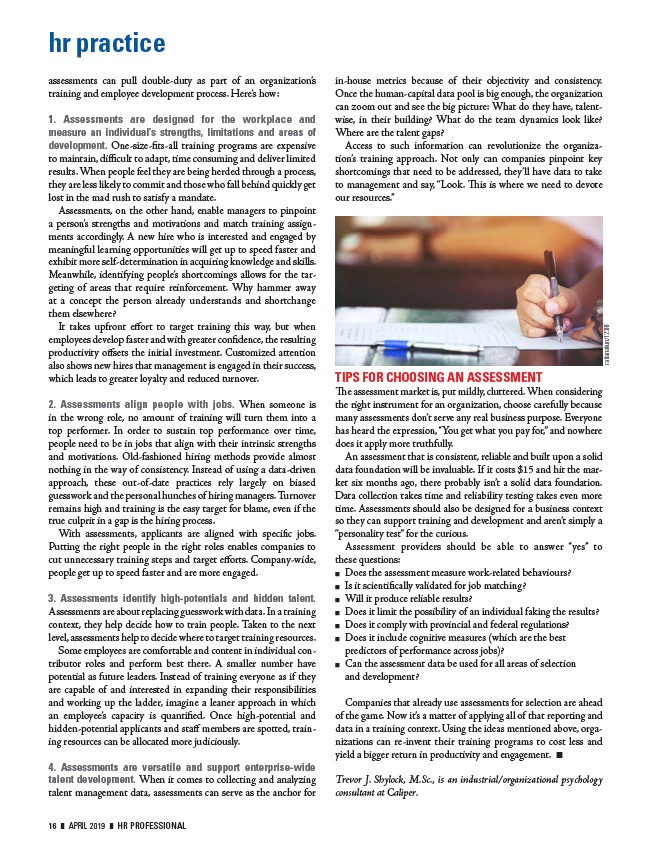
assessments can pull double-duty as part of an organization’s
training and employee development process. Here’s how:
1. Assessments are designed for the workplace and
measure an individual’s strengths, limitations and areas of
development. One-size-fits-all training programs are expensive
to maintain, difficult to adapt, time consuming and deliver limited
results. When people feel they are being herded through a process,
they are less likely to commit and those who fall behind quickly get
lost in the mad rush to satisfy a mandate.
Assessments, on the other hand, enable managers to pinpoint
a person’s strengths and motivations and match training assignments
accordingly. A new hire who is interested and engaged by
meaningful learning opportunities will get up to speed faster and
exhibit more self-determination in acquiring knowledge and skills.
Meanwhile, identifying people’s shortcomings allows for the targeting
of areas that require reinforcement. Why hammer away
at a concept the person already understands and shortchange
them elsewhere?
It takes upfront effort to target training this way, but when
employees develop faster and with greater confidence, the resulting
productivity offsets the initial investment. Customized attention
also shows new hires that management is engaged in their success,
which leads to greater loyalty and reduced turnover.
2. Assessments align people with jobs. When someone is
in the wrong role, no amount of training will turn them into a
top performer. In order to sustain top performance over time,
people need to be in jobs that align with their intrinsic strengths
and motivations. Old-fashioned hiring methods provide almost
nothing in the way of consistency. Instead of using a data-driven
approach, these out-of-date practices rely largely on biased
guesswork and the personal hunches of hiring managers. Turnover
remains high and training is the easy target for blame, even if the
true culprit in a gap is the hiring process.
With assessments, applicants are aligned with specific jobs.
Putting the right people in the right roles enables companies to
cut unnecessary training steps and target efforts. Company-wide,
people get up to speed faster and are more engaged.
3. Assessments identify high-potentials and hidden talent.
Assessments are about replacing guesswork with data. In a training
context, they help decide how to train people. Taken to the next
level, assessments help to decide where to target training resources.
Some employees are comfortable and content in individual contributor
roles and perform best there. A smaller number have
potential as future leaders. Instead of training everyone as if they
are capable of and interested in expanding their responsibilities
and working up the ladder, imagine a leaner approach in which
an employee’s capacity is quantified. Once high-potential and
hidden-potential applicants and staff members are spotted, training
resources can be allocated more judiciously.
4. Assessments are versatile and support enterprise-wide
talent development. When it comes to collecting and analyzing
talent management data, assessments can serve as the anchor for
in-house metrics because of their objectivity and consistency.
Once the human-capital data pool is big enough, the organization
can zoom out and see the big picture: What do they have, talentwise,
in their building? What do the team dynamics look like?
Where are the talent gaps?
Access to such information can revolutionize the organization’s
training approach. Not only can companies pinpoint key
shortcomings that need to be addressed, they’ll have data to take
to management and say, “Look. This is where we need to devote
our resources.”
TIPS FOR CHOOSING AN ASSESSMENT
The assessment market is, put mildly, cluttered. When considering
the right instrument for an organization, choose carefully because
many assessments don’t serve any real business purpose. Everyone
has heard the expression, “You get what you pay for,” and nowhere
does it apply more truthfully.
An assessment that is consistent, reliable and built upon a solid
data foundation will be invaluable. If it costs $15 and hit the market
six months ago, there probably isn’t a solid data foundation.
Data collection takes time and reliability testing takes even more
time. Assessments should also be designed for a business context
so they can support training and development and aren’t simply a
“personality test” for the curious.
Assessment providers should be able to answer “yes” to
these questions:
■■ Does the assessment measure work-related behaviours?
■■ Is it scientifically validated for job matching?
■■ Will it produce reliable results?
■■ Does it limit the possibility of an individual faking the results?
■■ Does it comply with provincial and federal regulations?
■■ Does it include cognitive measures (which are the best
predictors of performance across jobs)?
■■ Can the assessment data be used for all areas of selection
and development?
Companies that already use assessments for selection are ahead
of the game. Now it’s a matter of applying all of that reporting and
data in a training context. Using the ideas mentioned above, organizations
can re-invent their training programs to cost less and
yield a bigger return in productivity and engagement. n
Trevor J. Shylock, M.Sc., is an industrial/organizational psychology
consultant at Caliper.
hr practice
rattanakun/123RF
16 ❚ APRIL 2019 ❚ HR PROFESSIONAL